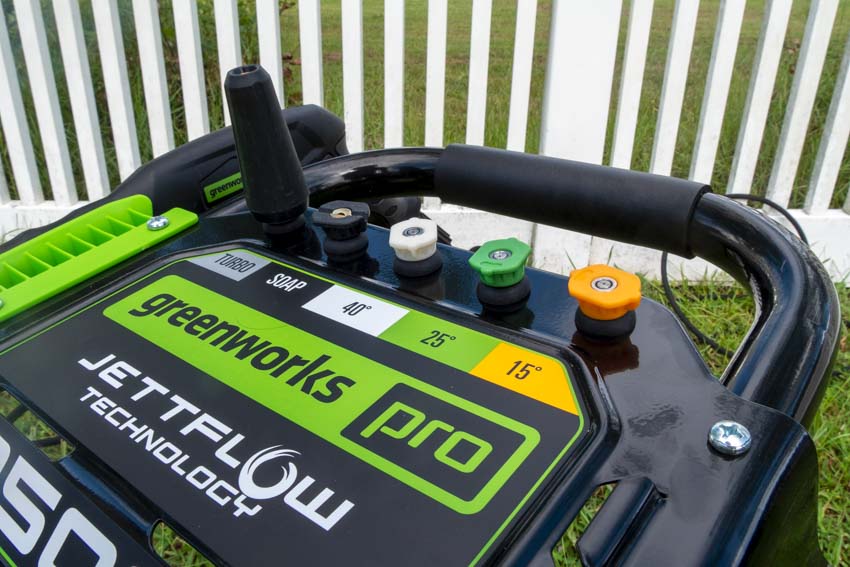So you finally picked up the best pressure washer and you’re ready to clean. Choosing the right nozzle will make the chores as efficient as possible while minimizing the risk of damage. In this guide, I’ll help you understand the method behind the madness and show you how to select the right tip for the job.
Check out our best electric pressure washer article to see our top picks.
Jump to a Section
- Pressure Washer Nozzle Basics
- Choosing the Right Standard Nozzle (0° – 40°)
- Choosing the Right Specialty Nozzle
Pressure Washer Nozzle Basics
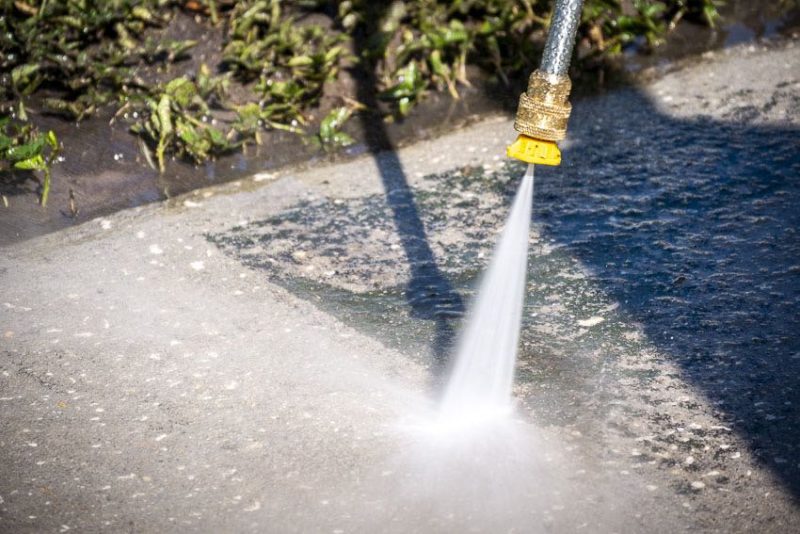
Pressure washers typically come with a set of nozzles. Just how many may vary, but there are six basic types: 0°, 15°, 25°, 40°, soap, and Turbo. We’ll go over each one in detail and explain how it works, what it’s for, and why you might want to use one type over another.
When you see an angle, that refers to how wide of a triangle pattern the nozzle makes as you work. Smaller angles have a higher pressure, a smaller coverage area, and deliver lower water volume. Going with a higher angle has the opposite effect.
Pressure Washer Nozzle Ratings
Many people don’t know that pressure washer nozzles have a PSI rating. If you need to replace any or you’re expanding on what came with your model, be sure to check the rating. It’s okay to choose nozzles rated for more pressure than your pressure washer has. You can damage nozzles that are rated too low, though, and the last thing you want is high-pressure shrapnel flying around.
Pressure Washer PSI and Nozzle Distance
If you use a 25° nozzle with a 2000 PSI pressure washer, you’ll get different results than using the same tip in a 3500 PSI model.
With the less powerful model, you need to get the tip closer to the surface you’re cleaning to make progress. As you get the nozzle closer to the surface, the width of the cleaning swath gets smaller, taking longer to clean.
If you have a stronger model, there are not only more types of jobs it can do, but it’s also faster at the smaller jobs since you can clean a wider area or use a wider nozzle.
Choosing the Right Standard Pressure Washer Nozzle (0° – 40°)
Getting Started
The trick with choosing the right pressure washer nozzle is to find the widest tip you can use that still cleans the surface effectively. That way, you make the most efficient use of your pressure washer and your time.
If you’re working on a surface you’ve never cleaned before, start with a 40° pressure washer nozzle in a spot that’s out of the way. Hit the trigger with the nozzle about 2 feet away from the surface and push in closer until you see it starting to clean. If you don’t see results by the time the nozzle is a few inches away, try the next size down and repeat until you’re making headway without damaging the surface.
If you do notice you’re starting to damage what you’re working on, back off immediately and either clean from a little farther away or switch to a wider nozzle.
Red 0° Nozzle
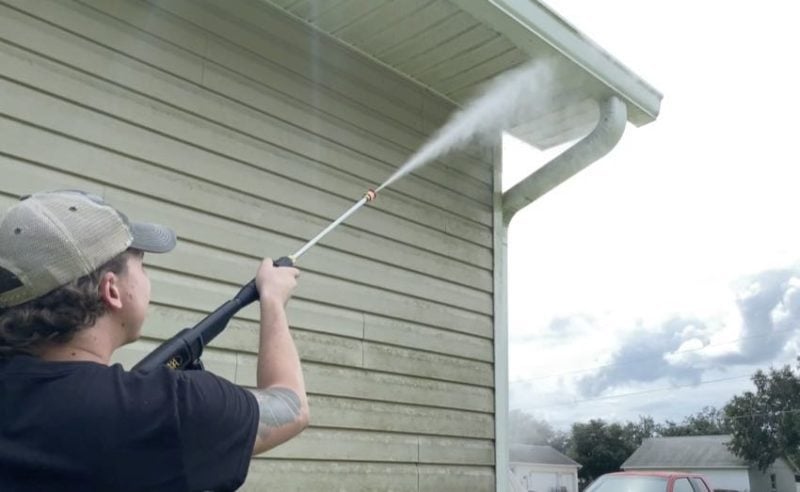
Selecting the right nozzle for the job is all about getting the pressure you want. The 0° nozzle gives you the absolute highest pressure. When you see the PSI rating for a pressure washer, that max rating was achieved using the 0° spray tip.
Use a Red 0° nozzle only for reaching high areas like soffits where that extra pressure gives you better access. It can also really help remove super-tough stains and debris from concrete and metal. Get it too close, however, and you can literally carve your initials in your driveway!
You also don’t want to use this tip on painted surfaces, siding, or wood since it can easily remove coatings and ruin softer materials.
It should go without saying that you need to wear close-toed shoes when using a pressure washer, but I’m going to say it anyway.
Be really careful that the 0° tip never touches any part of you or anyone else. Any of the nozzles up to 40° can take off skin, but that 0° can do serious damage and even cut into your muscles.
Yellow 15° Nozzle
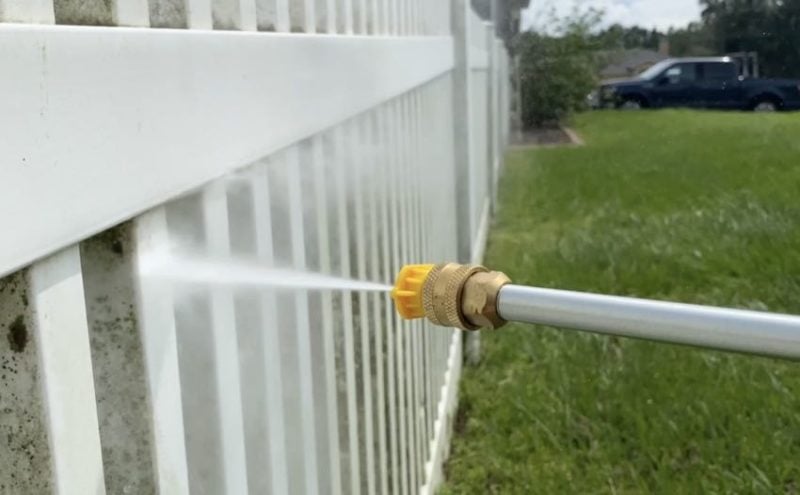
The Yellow 15° pressure washer nozzle works really well for tough stains like mold and mildew on PVC fences. For lower-powered pressure washers below 2000 PSI, this is your best bet for concrete cleaning. For high-power pressure washers, it can be your paint-removal specialist.
Regardless of your pressure washer’s power level, the 15° tip gives you a very strong spray, so don’t “linger” in one area for too long. It can removal surface coatings and dig into softer materials easily if you’re not careful.
Green 25° Nozzle
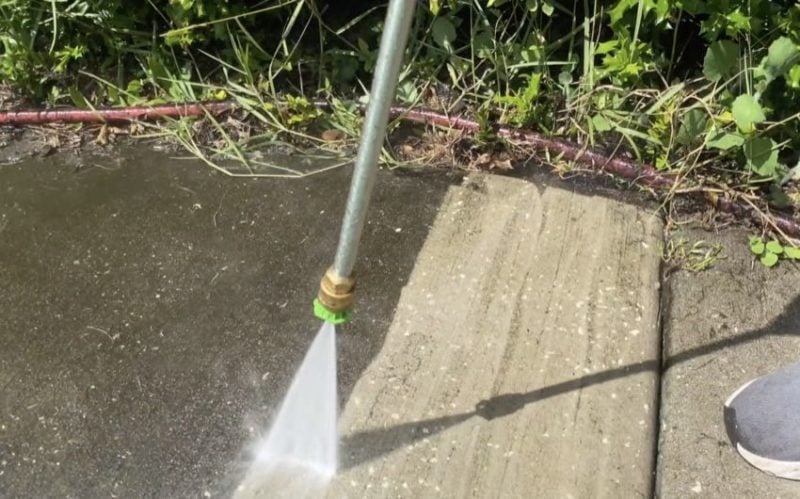
Use the Green 25° nozzle to safely clean siding, decks, sidewalks, or driveways. It also works well to remove stubborn dirt or mud from off-road vehicles and wheels. Just keep a safe distance away to ensure you don’t damage the paint. This is a great all-around nozzle and a great go-to if you’re unsure of where to start.
White 40° Nozzle
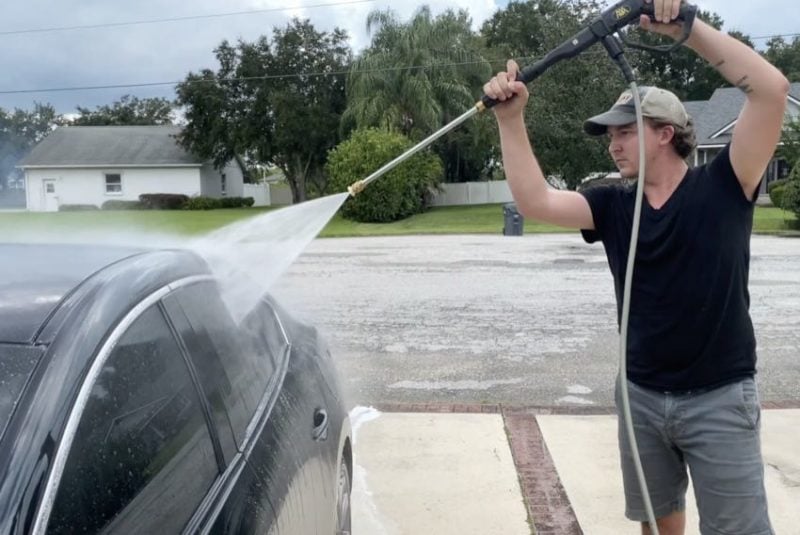
The 40° White pressure washer nozzle gives you the widest spray pattern. Use this tip for spraying and hosing down the car, washing windows, cleaning screens, and anywhere you want to rinse something off. If a surface is delicate, this nozzle lets you apply a wider spray with less pressure so you don’t damage it.
Choosing the Right Specialty Pressure Washer Nozzle
There are other types of pressure washer nozzles worth choosing. These can make more efficient use of your time or expand the versatility of your pressure washer.
Turbo Nozzle
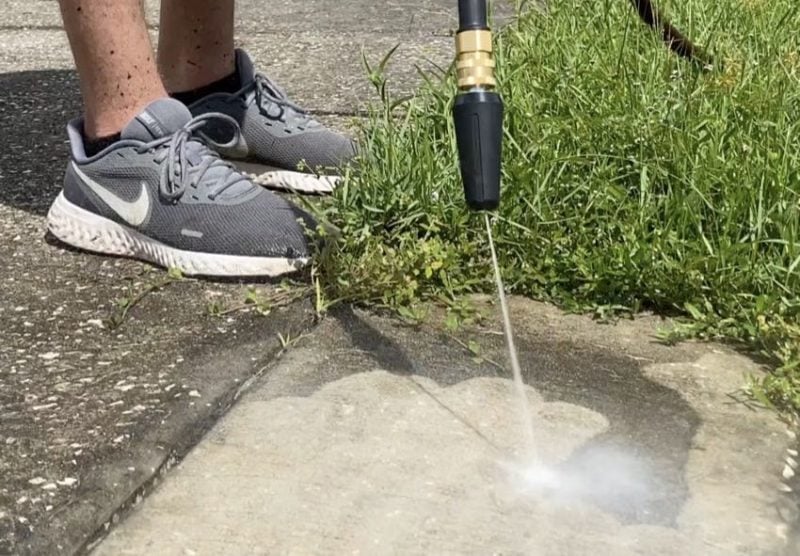
Let’s start with that Turbo nozzle. This is really a great invention because it takes the power of 0° tip and rotates it rapidly to cover a conical roughly the diameter provided by a 25° tip. That means you can rapidly clean larger areas with a higher level of pressure since you get both pressure and coverage.
Use it on the same areas that can handle a 0° or 15° nozzle without damage. Just be sure to test the area first if you’re not sure.
We love how it helps clean concrete landscape edging. Simply move it along at a rapid pace to avoid damaging the softer concrete.
Especially for electric pressure washers, it can help you clean with the efficiency of a much stronger gas model with a 25° tip. If your pressure washer didn’t come with a turbo nozzle, you should look into buying one.
Soap Nozzle
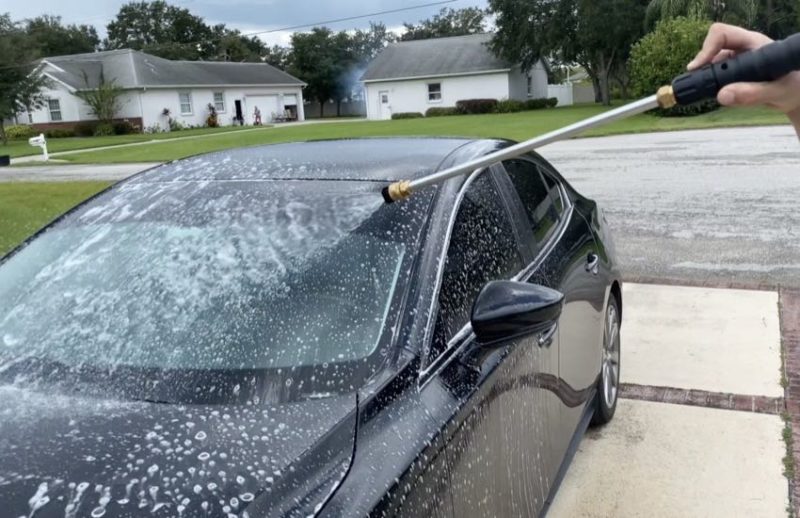
If you happen to have a soap nozzle, these typically work alongside a delivery system when spraying detergent or a foaming agent. Most pressure washers either have an onboard detergent tank or allow you to connect a tube directly to a detergent container that automatically mixes it with the water, usually at a 20:1 ratio.
This nozzle lets you quickly and easily spray down a vehicle, boat, or surface without fear of damaging delicate paints or materials while applying a chemical booster to help with cleaning.
Instead of having high pressure, this tip has one of the highest volume (GPM) deliveries. Keep an eye on your detergent levels while you’re applying it—you might be surprised how quickly you go through it!
That high volume also makes the soap nozzle a great choice for rinsing. Use it without any detergent and get a low-pressure rinse for vehicles, boats, RV’s, and more.
Multi-Tip Nozzles

In recent years, multi-tip nozzles have become more widespread. Similar to a multi-pattern garden hose, you turn the head to get different spray angles. While these usually don’t have a turbo nozzle in the mix, they often have some combination of 0° – 40° nozzles, plus the soap tip.
The great thing about these is that you don’t have to swap tips. Choose the pattern you want and get to work. If you need to switch, it takes just a couple of seconds to turn the dial.
There are a couple of downsides, though. One is that these nozzles are heavier than single tips. If you’re pressure washing walls and windows, you might feel it in your arms more.
The other is that these are usually limited to 3300 PSI or lower. If you’re using a higher-performance gas model, you’re out of luck.
Foam Cannons
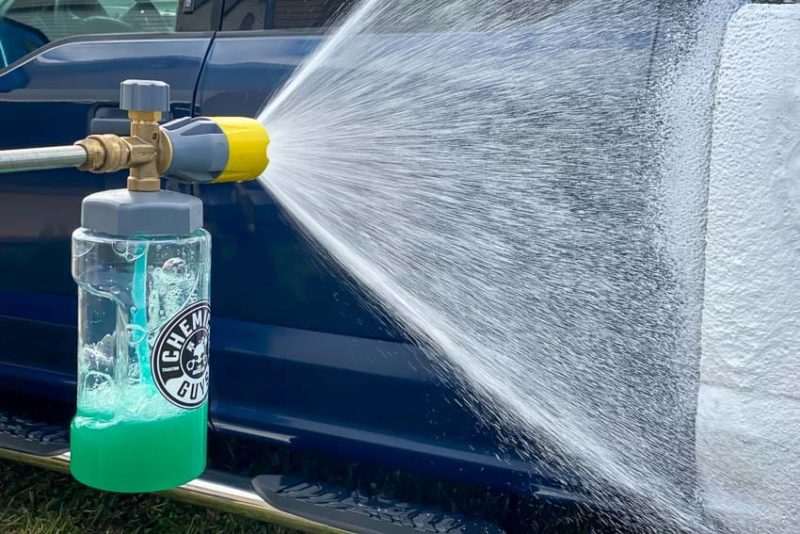
Foam cannons connect directly to the end of your wand. They actively mix water, soap, and air to create a thick foam that stays on surfaces longer to loosen dirt and grime. You can adjust the nozzle to get the right amount of foaming action you want. Some models also let you adjust the amount of soap you’re using and shut it off completely so you can rinse without removing the foam cannon.
Primarily used for cleaning vehicles, pair it with a high-foam car-friendly soap to get the best results.
Surface Cleaners

Surface cleaners are your best friend when you’re pressure washing concrete. They consist of a protective dome with tubing that splits into two nozzles underneath. When you pull the trigger, the pressure causes them to spin like a lawn mower blade, cleaning a much wider path than other types of nozzles.
Stick close to the PSI ratings with surface cleaners, though. Never use one rated for lower pressure than your pressure washer has. On the other hand, if your pressure washer has a much lower PSI than the surface cleaner rating, you might not be able to clean effectively.
This accessory offers serious time savings. I have a 4-car driveway with a sidewalk running in front of my house. The 15-inch surface cleaner I use with my 3400 PSI pressure washer turns a 2-hour job into a 30-minute one.
If you clean concrete, you should own a surface cleaner. And if you see your neighbor bent over a 25° nozzle, do them a solid and let them borrow yours.

